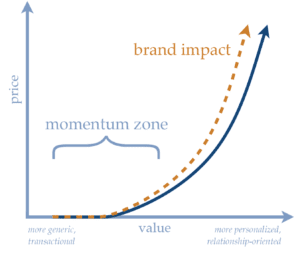When trying to understand what it takes to succeed in the education business –particularly when it comes to increasing sales – there are many factors to consider. And it usually doesn’t have anything to do with having the latest bells and whistles, or perhaps a huge catalog of offerings. In fact, what we’ve observed over two decades of extensive research and consulting, is that it typically comes down to three fundamental areas.
In this episode, we examine the three factors that often impact and limit sales of education. We also discuss the important takeaways and questions learning businesses need to consider when trying to achieve success in each of these key areas.
To tune in, just click below. To make sure you catch all of the future episodes, be sure to subscribe by RSS, Apple Podcasts, Spotify, Stitcher Radio, iHeartRadio, PodBean, or any podcatcher service you may use (e.g., Overcast). And, if you like the podcast, be sure to give it a tweet!
Listen to the Show
Read the Show Notes
[00:18] – A preview of what will be covered in this episode where Jeff and Celisa discuss three factors that limit sales of education.
Reflection Questions

[01:18] – You might consider the reflections questions below on your own after listening to an episode, and/or you might pull the team together, using part or all of the podcast episode for a group discussion.
- To what extent do we have a market, but not an audience? How might we solidify our audience?
- How strong is our brand, and what might we do to strengthen it?
- To what extent are we selling information rather than impact? How might we shift more toward impact?
[01:31] – And now to the first factor that limits the sales of education:
1. You have a market, but not an audience
It’s important to realize that having a market is not the same thing as having an audience.
Your market is the broad group of people who you can reasonably expect to be interested in what you have to offer. They may be the people who work in a particular field or industry or who fit a certain set of demographic characteristics. They’re the people businesses will often spend a lot of time developing “personas” to describe.
An audience, on the other hand, is the subset of these people who actually know and care about what you have to offer and with whom you have built a connection.
These are the people you can usually count on to buy when you create a new offering for them and—perhaps more importantly—they are the people who will help spread the word and attract others to you. They help you realize the potential of your market.
Building an audience is about building relationships, which means that it does, of course, require a certain amount time and effort.
This doesn’t mean you need to have one-on-one conversations with every one of your prospective customers, but it does mean you need to consistently show up in ways that are useful—not just salesy—and really be available to engage. You can do this through things like blogging, speaking, creating videos, interacting on social media, or any number of other ways.
It also doesn’t mean you won’t end up with some purely transactional sales—that is, sales to people who buy something from you before you have established a strong relationship with them. That will happen—particularly if you have a strong brand, which we’ll get to in a minute—but very often these people are persuaded by “proxy” relationships—like referrals, testimonials from your established audience—that will pull them in.
And you actually want these types of sales because they are essential to driving significant growth. But the key is that you then have to build your own relationship with these customers if you expect them to stay around. You have to convert them from being a part of your market to being a part of your audience.
It’s important to note here (since we have many listeners who represent trade and professional associations or other types of membership organizations) that having a membership does not automatically mean that you have an audience.
Probably most listeners recognize the fact that very often you have quite a few “checkbook” members—doing it because it’s the thing to do if you’re in that field or profession, but they may not really be tuned in. Even beyond that, people have different expectations/a different perspective on what it means to be a member and the value they get out of membership.
And they may not be looking at or even thinking about the fact that you’ve got an education/training/learning business within that overall membership structure. So, they may not be identifying as sort of the audience for your education business even if they are identifying as the audience for your membership.
The takeaway here is it takes time and effort to build an audience but that’s precisely why it’s so valuable. Once you have a solid audience, it is very hard for anyone else to take your place with this group of people, and it becomes an invaluable asset for the long-term success of your learning business.
Sponsor: Community Brands
[06:01] – If you are looking for a platform that can help you build and manage your audience, check out our sponsor for this quarter.
Community Brands provides a suite of cloud-based software for organizations to engage and grow relationships with the individuals they serve, including association management software, learning management software, job board software, and event management software. Community Brands’ award-winning Crowd Wisdom learning platform is among the world’s best LMSes for corporate extended enterprise and is a leading LMS for association-driven professional education programs. Award-winning Freestone, Community Brands’ live event learning platform, is a leading platform for live learning event capture, Webinars, Webcasts, and on-demand streaming.
Now, on to the second factor …
2. You don’t have a brand
[07:04] – Along with building an audience, learning businesses that expect to succeed over the long haul need to build a brand. There are a number of reasons for this.
First, while your easiest—and often, best—sales are going to come from people who are part of your audience, it’s much harder to grow if you have to rely on your established audience for all of your sales. As mentioned above, the stronger your brand, the less of a relationship you’ll need to be able to convert new prospects. Your brand becomes a proxy for that relationship and the value you offer.
Of course, as noted above, you have to fulfill that brand promise if you expect those prospects then to stick around as customers.
Next, your brand really is one of your most powerful competitive assets. Your prospects will inevitably have options when it comes to pursuing education in the topics you cover. Ideally, you don’t want them to be thinking, “I need to get some education on topic X,” you want them to be thinking, “I need what [Brand x] has to offer.”—where brand X is your brand. That’s much more likely to bring them straight to your Web site or to get them to type your brand into a search—which, by the way, is something Google values more and more in its search rankings.
Finally, your brand helps to support your price, making it much more likely that you will get conversions at whatever price you charge. We’ve made this point before with the Value Ramp™. A strong brand increases value perception and makes your value curve steeper, meaning you are able to charge more sooner—and, as a result grow faster and bigger.
To learn more about that Value Ramp™, see our related episode, 8 Tips for Optimizing Your Value Ramp.

Keep in mind, though, that “brand” is not just about having a clever name and attractive logo. Brand is really the sum total of all your interactions with your prospects and customers, which is one reason the next factor is so critical:
3. You sell information, not impact
[09:49] – As part of our work with clients, we do a lot of surveying of their markets and audiences—basically, the lifelong learners they aim to serve—and a question we typically ask is about the value factors these people consider when deciding whether to purchase an educational product.
We have not been very surprised that the reputation of the teacher is almost always the most important value factor. (There’s brand again). We have, on the other hand, been surprised that survey respondents have consistently ranked as number two or three, “Has been shown to produce demonstrable improvement in knowledge or performance for those who take part.”
In other words, learners are actually looking for results—especially if they are going to pay money.
And, employers—who often foot the bill for education and training—also want results. Keep that in mind if you are selling educational experiences that relate directly to people’s jobs and careers.
The sad fact is that much of what gets positioned as education—whether online or off—isn’t education at all. It’s just information. As the (now) old saying goes, information wants to be free. And, these days, the people consuming it expect it to be free—mostly because they know they can almost always find it somewhere for free.
This is the main reason we’ve mentioned before the idea that if you’re going to sell Webinars (as so many organizations want to do), you have to stop calling them “Webinars”. This goes back to branding but people expect Webinars to generally be informational and they expect them to be free.
So, if what you are offering is really just information, don’t expect to be able to charge for it. And that goes triple if you don’t have an audience or a brand.
Of course, there are exceptions. If you have truly original information that really can’t be found anywhere else—based, for example, on unique research or on special access to sources—then you may be able to charge for it—and maybe even a lot for it. But those are just exceptions that prove the rule. Most courses do not really offer truly original information, as much as their creators may like to think they do.
What is original is who is delivering the information, how it is packaged and structured, and, most importantly, how well the learner will be able to retain and make use of the information. That last part requires design. It requires an understanding of how adults learn. It requires skill at guiding and facilitating learning in a way that the experience will result in a positive impact for the learner.
To learn more, check out our related episodes:
- Design for How People Learn with Julie Dirksen
- Designing Smarter Learning Experiences with Connie Malamed
- Diving into Deeper Learning with Dr. Patti Shank
- Action Mapping and Activity Design with Cathy Moore
And, by the way, being able to demonstrate that impact has been achieved—through data, through testimonials—is one of the most effective ways to bolster your marketing and your brand.
So, honestly evaluate your offerings and ask, is this really education or is it just information? (One strong clue is that—regardless of whatever they say in their evaluations—your learners don’t consistently come back for more.)
Working backwards to increase sales
[14:23] – In most cases, the last of these factors—impact—is the one that can be addressed most rapidly, and it’s also the foundation on which the others can be built over time.
Whether you are creating your first or your fiftieth educational offering, there are almost certainly steps you can take right now to improve their instructional effectiveness and increase impact. For example, you can be more thoughtful and intentional in your approach to design, make sure you are adhering to principles of adult learning, or pilot new offerings to gain feedback from and build connection with your audience.
These are approaches that, when done right, practically ensure that you will better understand the people you seek to serve and how you can provide the most value to them.
You then can start sharing significant parts of that value freely to attract your audience to you and start building relationships. Over time, the value you create and the relationships you develop will build and strengthen your brand. This is the essence of the best, most effective content marketing.
It’s also the essence of long-term success for any business that exists to create value through learning.
[15:59] – Wrap-Up
Reflection Questions

- To what extent do we have a market, but not an audience? How might we solidify our audience?
- How strong is our brand, and what might we do to strengthen it?
- To what extent are we selling information rather than impact? How might we shift more toward impact?
If you are getting value from the Leading Learning podcast, be sure to subscribe by RSS, Apple Podcasts, Spotify, Stitcher Radio, iHeartRadio, PodBean, or any podcatcher service you may use (e.g., Overcast).
We’d also appreciate if you give us a rating on Apple Podcasts by going to https://www.leadinglearning.com/apple. We personally appreciate your rating and review, but more importantly reviews and ratings play a big role in helping the podcast show up when people search for content on leading a learning business.
And we would be grateful if you check out our sponsor for this quarter. Find out more about Community Brands.
Finally, consider following us and sharing the good word about Leading Learning. You can find us on Twitter, Facebook, and LinkedIn. We also encourage you to use the hashtag #leadinglearning on each of those channels. However you do it, please do follow us and help spread the word about Leading Learning.
[18:58] – Sign off
See Also:



 Innovation and Credit for Prior Learning with Louis Soares of ACE
Innovation and Credit for Prior Learning with Louis Soares of ACE
Leave a Reply